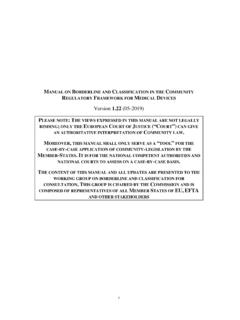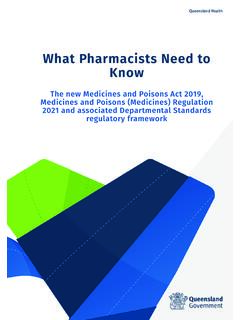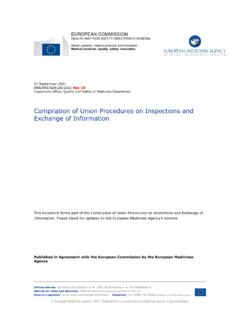Transcription of Guidance on regulatory requirements for medical face masks
1 EUROPEAN COMMISSION DIRECTORATE-GENERAL FOR HEALTH AND FOOD SAFETY Health systems, medical products and innovation medical Devices Guidance on regulatory requirements for medical face masks Options for supporting production and/or placing on the market of medical face masks in the context of COVID-19 pandemic 2 1. INTRODUCTION The World Health Organization (WHO) declared the COVID-19 outbreak a pandemic on March the 12th 2020. The COVID-19 virus is transmitted mainly via small airborne droplets emitted by infected people, especially when sneezing, coughing or talking. Therefore, a wide array of protective products designed to ensure protection against airborne particles or small droplets are used, such as: face masks , gloves, coveralls, etc. A medical face mask (also known as surgical or procedure mask) is a medical device covering the mouth, nose and chin ensuring a barrier that limits the transition of an infective agent between the hospital staff and the patient.
2 They are used by healthcare workers to prevent large respiratory droplets and splashes from reaching the mouth and the nose of the wearer and help reduce and/or control at the source the spread of large respiratory droplets from the person wearing the face mask1. medical face masks are recommended, as well, as a means of source control for persons who are symptomatic in order to prevent the spread of respiratory droplets produced by coughing or sneezing. The application of medical masks as source control has been shown to decrease the release of respiratory droplets carrying respiratory viruses1. The European Centre for Disease Control (ECDC) have outlined recommendations on the preferential supply of medical face masks to healthcare professionals and symptomatic patients based on need and the emerging evidence1.
3 Other products such as face covers (also known as community / artisanal / textile / domestic / non- medical face masks ) include various forms of self-made or commercial masks or face covers made of cloth, other textiles or other materials such as paper. They are not intended for use in healthcare settings or by healthcare professionals. Manufacturers of medical face masks and face covers may include technological adaptation in the design of these products (with a transparent window), in order to allow lip reading for hearing impaired people (including healthcare professionals). Under the current COVID-19 context, the demand for different types of face masks has rapidly increased. Therefore, this document intends to outline the regulatory options for the placing of medical face masks on the EU market indicating their feasibility to allow short-term supply.
4 In addition to the use of masks and face covers, other public health measures must be promoted, such us respiratory etiquette ( covering of the mouth and nose with a tissue when coughing) to limit the spread of infection from an infected individual1. 1 See also the ECDC Technical report Using face masks in the community : 3 2. LEGAL BACKGROUND Most of these masks are among the so-called harmonised products for which there is specific EU product legislation in place. medical face masks or surgical face masks are products falling within the scope of the EU legal framework on medical devices Directive 93/42/EEC (MDD), to be replaced by Regulation (EU) 2017/745 (MDR) as from 26 May 2021.
5 Some products used in the COVID-19 context, such as filtering face-piece respirators (also called protective face masks or respirators), are considered as personal protective equipment (PPE) and hence fall under the scope of Regulation (EU) 2016/425 (PPER). A face covering is another type of mask, for which the EU regulatory framework has not established specific legal requirements . Therefore, the General Product Safety Directive (GPSD) 2001/95/EC would apply. In addition, some Member States, standardisation bodies or other entities may provide Guidance on the specifications and use of these face covers. 3. DEFINITION OF medical FACE masks AND INTENDED USE OF OTHER TYPES OF FACE masks medical Face Mask: medical device covering the mouth and nose providing a barrier to minimize the direct transmission of infective agents between staff and patient.
6 A medical face mask must fulfil the definition as a medical device and therefore have a medical purpose as intended by the manufacturer. This intended purpose is normally to limit the transmission of infective agents from staff to patients during surgical procedures and other medical settings with similar requirements . A medical face mask with an appropriate microbial barrier should also be effective in reducing the emission of infective agents from the nose and mouth of an asymptomatic carrier or a patient with clinical symptoms. medical face masks should be distinguished from protective face masks or respirators (PPE), which are intended only to be worn by a person for protection against one or more risks to that person's health or safety, without a medical purpose, and do not fall under the definition of medical device.
7 For further advice on the conformity assessment of these type of masks and other types of protective equipment, a questions and answers document has been published on the Commission web site: Face covers do not meet the legal definitions of a PPE and neither they meet the legal definition of a medical device, as there is no intended medical or personal protection purpose made by the manufacturer. However, some Member States, standardisation bodies or other entities may provide Guidance on the specifications and use of these face covers. 4 4. CLASSIFICATION Classification according to medical Devices Directive 93/42/EEC and medical Devices Regulation (EU) 2017/745 medical Face masks are classified according to Rule 1 for non-invasive devices, as devices that either do not touch the patient or contact intact skin only (see guidance2).
8 There are two possible classifications: - Class I: non-sterile medical face masks . For them, the manufacturer is entitled to carry out a self-assessment conformity procedure, without the intervention of a notified body. - Class Is: sterile medical face masks . For them, the intervention of a notified body is required in the assessment of the sterility process and validation of documentation. Classification according to the harmonised European standard EN 14683:2019+AC:2019 medical face masks are classified as Type I and Type II according to bacterial filtration efficiency, whereby Type II is further divided (Type II and IIR) according to whether or not the mask is splash resistant. The 'R' signifies splash resistance. Type I medical face masks should only be used for patients and other persons to reduce the risk of spread of infections particularly in epidemic or pandemic situations.
9 Type I masks are not intended for use by healthcare professional in an operating room or in other medical settings with similar requirements3. 5. USE OF HARMONISED EUROPEAN STANDARDS The use of harmonised European standards remains voluntary. Manufacturers are free to choose any other technical solution to demonstrate compliance with the mandatory legal requirements . The medical devices regulatory framework offers the possibility for manufacturers to rely on specific technical solutions, which are detailed in harmonised European standards or parts thereof. When the references of these harmonised European standards are published in the Official Journal of the European Union in support of the applicable EU legislation, the voluntary use of those standards confers presumption of conformity with the legal requirements the standard aims to cover.
10 It means that, where a manufacturer chooses to adopt the technical solutions laid down in those standards, the product is presumed to be in conformity with the applicable essential safety and performance requirements . This is the case of the abovementioned harmonised European standard EN 14683:2019+AC:2019 for medical face masks under the MDD. 2 MEDDEV - Classification of medical devices 3 See the harmonised European standard EN 14683:2019+AC:2019 medical face masks - requirements and test methods 5 6. regulatory OPTIONS FOR PLACING medical FACE masks ON THE EU MARKET AS medical DEVICES medical face masks in the scope of the MDD and the MDR4 must comply with the applicable essential safety and performance requirements .












